You'll find that pioneers chose wooden churns for butter-making because wood provided ideal properties for the task. The natural insulation of hardwoods like oak and cedar maintained the critical 50-60°F temperature needed for proper butter formation. Wood's moisture control abilities, durability, and easy repair made these churns reliable workhorses that lasted generations. The material's natural absorption helped remove excess moisture while creating tight seals to prevent leakage. Additionally, wooden churns became central to family traditions, with specific techniques and rhymes passed down through generations. These remarkable tools hold many more fascinating secrets about pioneer life.
Wooden Churns in Pioneer Life
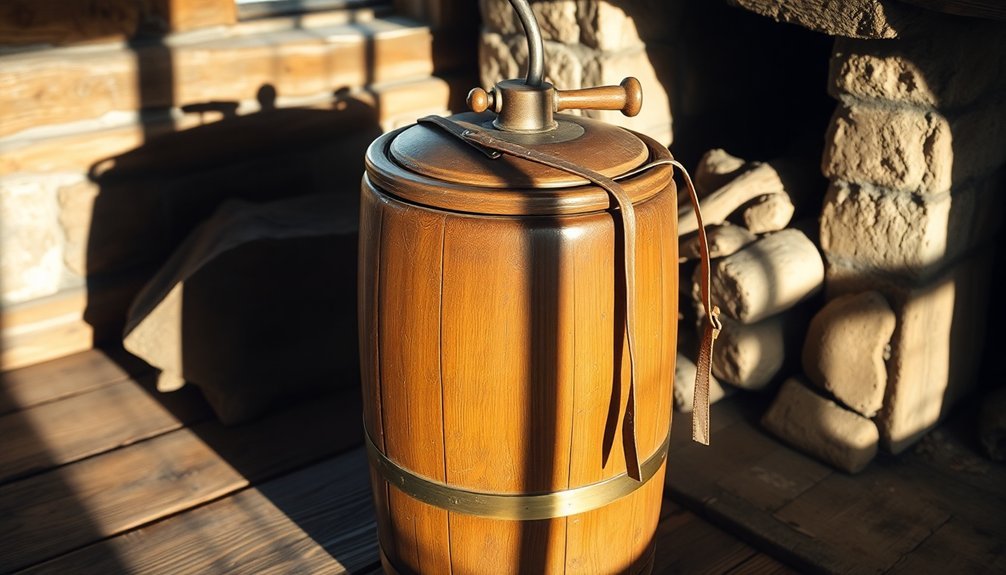
Making butter was a cornerstone of pioneer life, with wooden churns serving as essential household tools from the earliest settlements through the frontier era. When you look at pioneer households, you'll find that wooden churns were central to their daily routines, following a butter-making tradition that stretched back thousands of years.
You'd typically see several types of wooden churns in pioneer homes, from simple plunger designs to more sophisticated barrel models mounted on standing platforms. Early settlers learned these techniques from observing how nomadic tribes discovered butter-making through the natural motion of milk in traveling sacks. The wooden construction wasn't just traditional – it served practical purposes in maintaining proper temperatures and providing durability for the repetitive churning motion.
You'd find that most families relied on either the vertical dasher churn or the horizontal barrel churn for their butter-making needs.
The churning process would often become a family affair, though it was primarily considered women's work. You might spend anywhere from 10 minutes to three hours churning, depending on factors like weather and cream temperature.
When the butter finally formed, you'd need to wash it in cold water, knead it thoroughly, and add salt to preserve it for household use.
Materials and Construction Benefits
If you'd built pioneer butter churns, you'd understand why wood was the perfect material choice for withstanding constant use and repetitive motions.
The wood's natural properties helped control moisture, as it would swell when wet to create watertight seals without needing additional sealants.
Your wooden churn could last for generations with proper care, thanks to the sturdy construction techniques like tongue-and-groove joints and angled board fitting. Regular wooden churns, like the one purchased from Beaver Buckets at Stephenson House, demonstrate impressive durability with consistent use.
Durability Against Daily Use
Pioneer butter churns' wooden construction proved remarkably durable against the demanding rigors of daily use. You'll find that the combination of sturdy hardwoods like cedar and innovative tongue-and-grooved joints created a reliable tool that could withstand hours of repetitive motion. The design's structural integrity came from its thoughtful engineering, featuring metal braces and cross-supports that distributed weight evenly. Soaking the wood before initial use helped ensure tight seals throughout the churn's working life.
| Feature | Purpose | Benefit |
|---|---|---|
| Wooden Paddles | Cream Agitation | Efficient Butter Formation |
| Cross Bracing | Structural Support | Enhanced Stability |
| Tongue-and-Groove | Joint Sealing | Leak Prevention |
| Metal Braces | Frame Reinforcement | Extended Lifespan |
What made these churns particularly resilient was their ability to perform consistently under varying conditions. The wood's natural resistance to decay, combined with proper maintenance through water-soaking and thorough cleaning, guaranteed longevity. You could repair or replace damaged parts easily, making these churns a sustainable choice for pioneer families. Their endurance is evident in the many centuries-old specimens that survive today, proof to the remarkable craftsmanship and material selection that went into their construction.
Moisture Control Properties
Wooden churns excelled at moisture control through their ingenious material properties and construction methods. The hardwoods used, typically oak or maple, possessed natural qualities that helped manage moisture during the butter-making process. When you'd soak the churn in water, the wood would swell slightly, creating tight seals between the tongue-and-grooved joints that prevented unwanted leakage.
The curved interior of the drum, combined with strategically placed wooden paddles, helped you achieve ideal agitation of the cream. As you'd churn, the fat globules would separate from the buttermilk more efficiently due to this design. You'd find that the wooden construction maintained cooler temperatures during churning, which was essential for proper butter formation and moisture separation.
The churn's design also supported effective moisture removal during the final stages. You could easily add cold water through the top opening to wash the butter, and the hole in the lid allowed you to drain the buttermilk efficiently.
The wooden material's natural absorption properties helped draw out excess moisture, while the cloth lining, when used, provided an additional barrier against unwanted moisture retention.
Temperature Control During Churning

You'll find that wooden churns were masters of temperature control, thanks to wood's natural ability to insulate and maintain consistent temperatures between 50-60 degrees Fahrenheit.
Your cream's temperature would stay remarkably steady throughout the churning process, unlike with metal containers that could cause unwanted temperature fluctuations.
During cold weather, the wood's insulating properties were especially valuable, helping pioneers maintain the warmer temperatures needed for churning winter cream when the milk fat was naturally harder.
Wood's Natural Insulation Properties
The remarkable cellular structure of wood played an essential role in keeping butter-making temperatures stable. When you examine wood at a microscopic level, you'll find countless tiny air pockets that act as natural insulators. These pockets slow down heat transfer, making wooden churns excellent at maintaining consistent temperatures during the butter-making process.
Wood's low thermal conductivity and diffusivity were especially important for pioneers, as they didn't have modern temperature control methods. The natural properties of wood helped keep the cream at ideal churning temperatures, particularly because:
- Wood's cellular structure traps air, creating a barrier against temperature fluctuations
- The material acts like a thermal battery, storing heat when it's warm and releasing it when temperatures drop
- Softwoods, which were commonly used for churns, provide better insulation than hardwoods
- Wood's natural moisture-regulating properties help maintain stable conditions
This natural temperature regulation was significant because butter formation requires specific temperature ranges to work properly.
While wood mightn't insulate as well as modern synthetic materials, its combination of thermal properties made it an optimal choice for pioneer butter churns.
Consistent Cream Temperature Maintenance
Maintaining consistent cream temperature proved critical for successful butter churning in pioneer households. You'd need to keep the cream between 50-60°F (10-15°C) for ideal results, though the exact temperature varied by season. Spring's softer milk fats required cooler temperatures, while winter's harder fats needed warmer conditions.
| Season | Fat Consistency | Ideal Temp Range |
|---|---|---|
| Spring | Soft | 50-55°F |
| Summer | Medium | 52-57°F |
| Fall | Medium-Hard | 55-58°F |
| Winter | Hard | 57-60°F |
While modern butter-making facilities use precise electronic controls, pioneers relied on wooden churns' natural properties to maintain steady temperatures. You couldn't control the temperature exactly, but you'd check the cream's consistency periodically during the churning process, which could last anywhere from 10 minutes to three hours. If the cream was too warm, you'd get greasy, soft butter; too cold, and it'd turn brittle. Pioneers would often let cream naturally clabber at room temperature before churning and use cold water for washing the butter to help maintain proper temperature during the final steps.
Cold Weather Churning Benefits
During cold weather, wooden churns offered pioneers distinct advantages for temperature control while making butter. Wood's natural insulating properties helped maintain the ideal churning temperature between 50°F and 60°F, which was vital for achieving the perfect balance of liquid and solid fats in the butter.
You'll find that cold weather churning provided several benefits when using wooden churns:
- The cooler temperatures naturally increased the fat percentage in the butter, resulting in a higher quality product.
- Winter feed typically produced harder fats, which worked well with wood's ability to maintain slightly warmer temperatures.
- The wooden churn's insulation prevented the cream from becoming too cold and brittle during the churning process.
- Cold weather made it easier to control the temperature throughout the entire butter-making process.
When you're churning in cold conditions, you want to avoid making the butter too brittle from excessive cold. The wooden churn's ability to maintain consistent temperatures helped pioneers achieve the right texture, even when working in challenging winter conditions.
This was especially important since they needed to continue the churning process until the fat clumps properly coalesced into butter.
Durability and Long Term Use
Pioneer families relied heavily on wooden churns throughout multiple generations, thanks to their exceptional durability and lasting performance. The secret to their longevity lay in the carefully selected hardwoods like oak and cedar, which could withstand constant agitation while resisting rot and insect damage.
You'll find that these churns were masterfully constructed using precise techniques, such as tongue-and-grooved joints and perfectly fitted staves, ensuring they wouldn't leak during use. Metal braces provided additional support, while well-designed internal components like dashers stood up to years of repeated churning.
If you'd maintained your wooden churn properly, it would've served you faithfully for decades. The key was to soak it before use to prevent leakage, clean it thoroughly after each churning session, and store it correctly to avoid excessive drying.
You'd also need to protect the wood from extreme conditions that could cause it to warp or crack. This attention to maintenance, combined with the robust construction and quality materials, meant your wooden churn would've been a reliable tool you could pass down to your children, making it a worthwhile investment for your pioneer household.
Cultural Heritage and Techniques
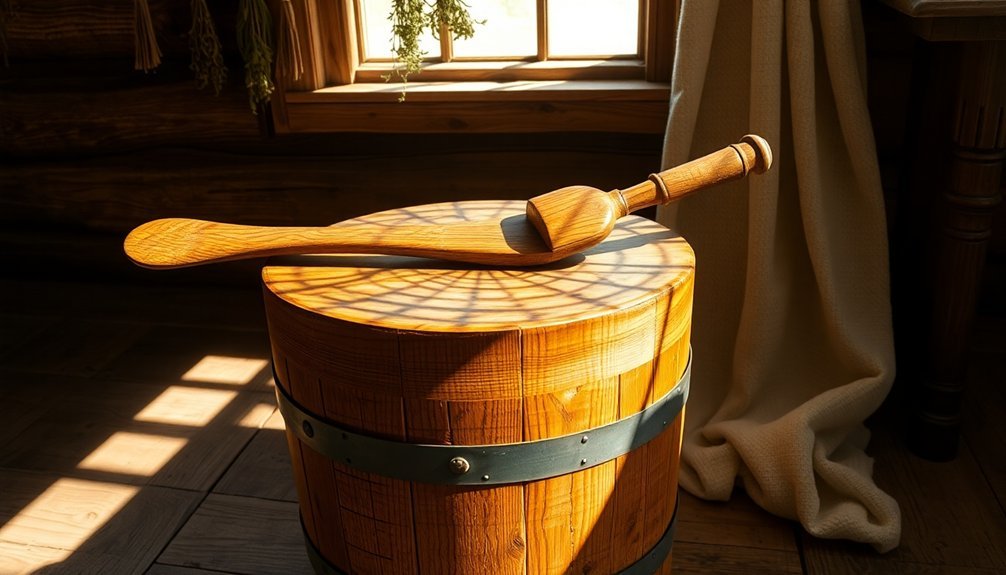
Churning butter was more than a daily chore for pioneer families – it was a deeply rooted cultural practice that brought households together. The process involved specific techniques passed down through generations, with families gathering to transform cream into butter using wooden churns made from carefully selected woods like oak.
You'd find pioneers using various churning methods, with the most common being the up-and-down motion of a dasher or paddle. They'd often let cream clabber overnight to make the churning process easier, and you'll find that different regions developed their own unique approaches to this vital task.
Here's what made pioneer churning techniques special:
- They'd use specific rhymes and chants to maintain rhythm during churning
- Salt wasn't just for taste – it served as a significant preservative
- Cold water washing removed excess buttermilk and improved shelf life
- Seasonal timing mattered – summer churning was faster than winter
The cultural significance of wooden churns extended beyond mere functionality. You'll find that these tools represented family tradition, community bonds, and important life skills that helped pioneers survive and thrive in challenging conditions.
Daily Butter Making Routine
The daily butter making process began long before dawn on pioneer homesteads. You'd start by milking the cows and carefully straining the fresh milk into clean containers.
You'd then let the milk sit undisturbed, allowing the cream to naturally rise to the surface. Each morning, you'd skim the cream off the top of yesterday's milk, ensuring you'd collected enough for a proper churning session.
You'd need to wait for the cream to reach about 60 degrees before transferring it to your wooden churn. If you were using raw cream from your farm cows, you might let it sit overnight to achieve complete separation.
Once your cream was ready, you'd begin the labor-intensive process of churning. You'd plunge the wooden dasher up and down repeatedly for about 30 minutes until butter clumps formed.
The liquid left behind would become buttermilk. After churning, you'd rinse the butter with cold water and knead it with a butter paddle to remove excess moisture.
Finally, you'd add salt for preservation and shape the butter into blocks or decorative molds before storing it in a cool, dry place.
Frequently Asked Questions
How Long Did Pioneers Typically Spend Churning Butter Each Day?
You'd spend 15-30 minutes actively churning butter, but the entire process took 1-3 hours daily, including cream preparation and working the butter to remove buttermilk and add salt.
Could Wooden Churns Be Used to Make Other Dairy Products Besides Butter?
Yes, you could use wooden churns to make cheese and yogurt too. In fact, nomadic groups often used their churns to process up to 30 kg of yogurt in one hour through similar agitation methods.
What Tools Did Pioneers Use to Clean and Sanitize Wooden Churns?
You'd clean wooden churns with cold water rinses, hot water scalding, and juniper branches for sanitizing. You could also use mild soap, salt rubs, and fine sandpaper, followed by sunlight exposure for bleaching.
How Many Pounds of Butter Could a Typical Wooden Churn Produce?
You'd typically get 2-4 pounds of butter from a standard wooden churn that held 1-5 gallons of cream. Your yield would depend on the cream's butterfat content and churning efficiency.
Did Different Wood Types Affect the Taste of Butter Made in Churns?
No, you won't notice taste differences from wood types in churned butter. The flavor comes primarily from your cream quality, churning method, and post-churning processes, not the wooden material used in the churn.
In Summary
You'll find that pioneers made a practical choice with wooden churns for numerous compelling reasons. They're naturally insulating, helping maintain ideal temperatures for butter formation. You can rely on their durability through years of daily use, and their porous nature actually helps develop beneficial bacteria for better-tasting butter. When you understand these benefits, you'll see why this traditional tool remained a staple in pioneer households.
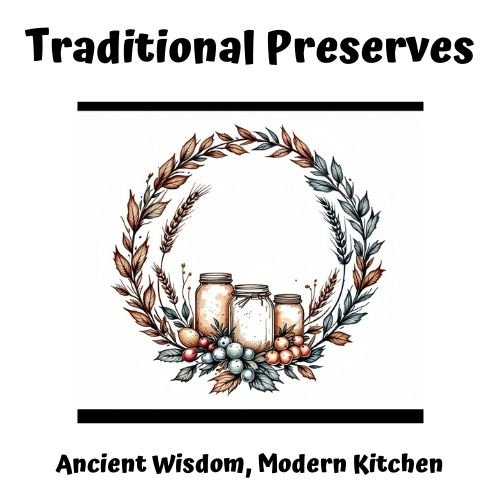

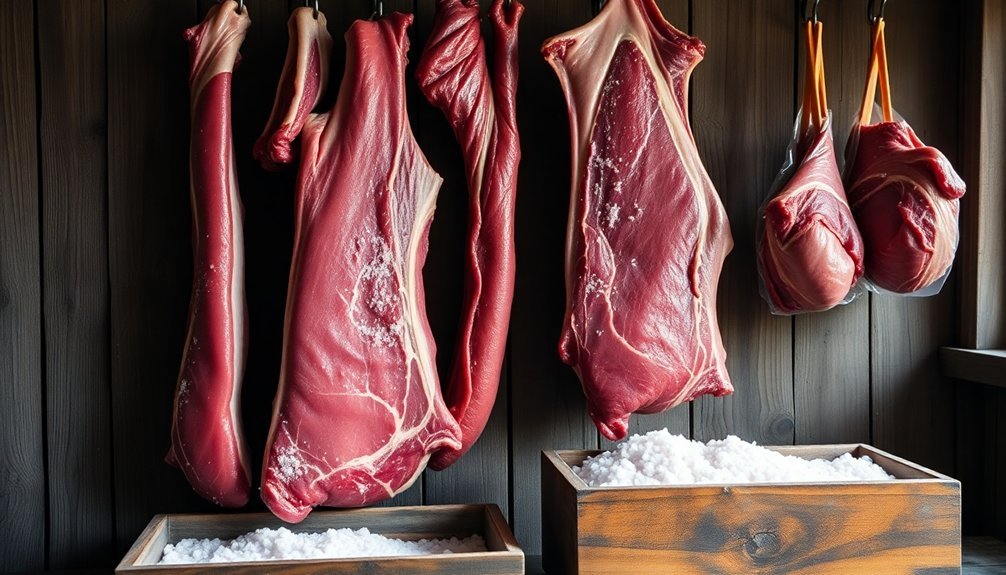
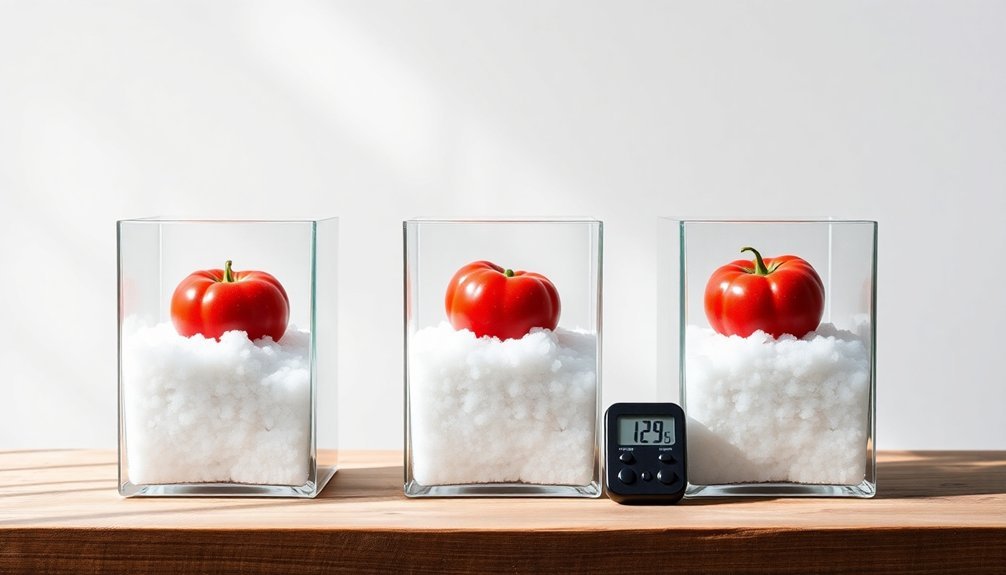
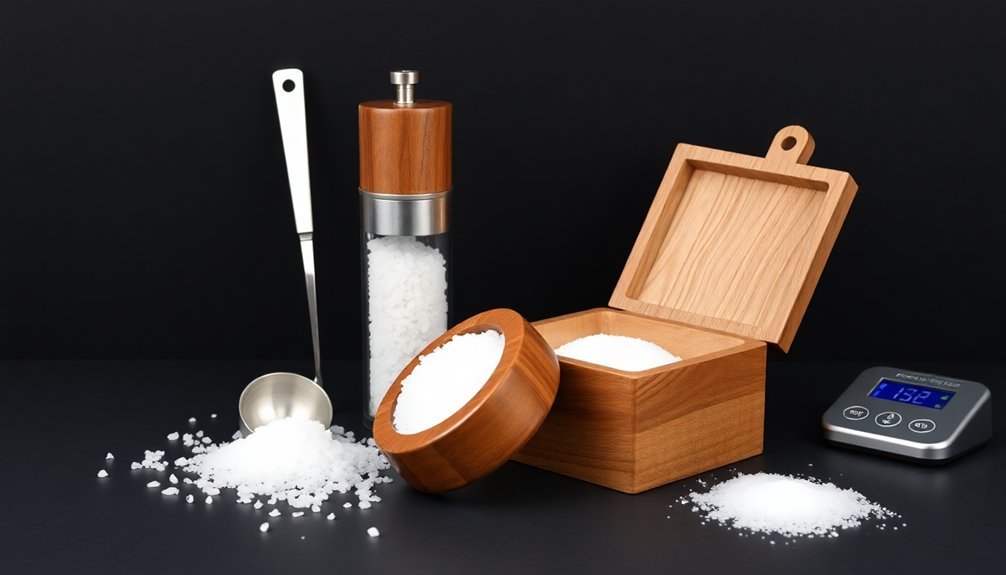
Leave a Reply